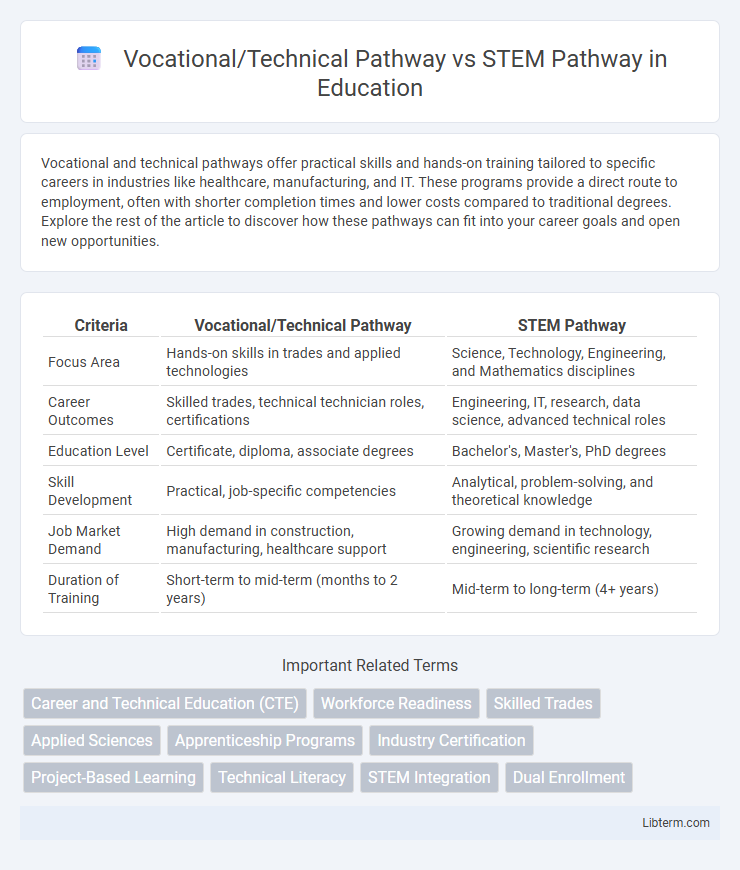Vocational and technical pathways offer practical skills and hands-on training tailored to specific careers in industries like healthcare, manufacturing, and IT. These programs provide a direct route to employment, often with shorter completion times and lower costs compared to traditional degrees. Explore the rest of the article to discover how these pathways can fit into your career goals and open new opportunities.
Table of Comparison
| Criteria | Vocational/Technical Pathway | STEM Pathway |
|---|---|---|
| Focus Area | Hands-on skills in trades and applied technologies | Science, Technology, Engineering, and Mathematics disciplines |
| Career Outcomes | Skilled trades, technical technician roles, certifications | Engineering, IT, research, data science, advanced technical roles |
| Education Level | Certificate, diploma, associate degrees | Bachelor's, Master's, PhD degrees |
| Skill Development | Practical, job-specific competencies | Analytical, problem-solving, and theoretical knowledge |
| Job Market Demand | High demand in construction, manufacturing, healthcare support | Growing demand in technology, engineering, scientific research |
| Duration of Training | Short-term to mid-term (months to 2 years) | Mid-term to long-term (4+ years) |
Understanding the Vocational/Technical Pathway
The Vocational/Technical Pathway emphasizes practical skills and hands-on training tailored to specific trades such as automotive technology, healthcare, and skilled manufacturing, providing direct preparation for the workforce. This pathway often includes certifications, apprenticeships, and industry-recognized credentials that enhance employability in specialized fields. Unlike the STEM Pathway, which centers on science, technology, engineering, and mathematics theory and innovation, the Vocational/Technical Pathway prioritizes immediate job readiness and technical proficiency.
What Defines the STEM Pathway?
The STEM pathway is defined by its focus on science, technology, engineering, and mathematics disciplines that prepare students for careers in innovation, research, and technical problem-solving. It emphasizes analytical thinking, advanced technical skills, and proficiency in digital tools and scientific methodologies. Core subjects include computer science, physics, chemistry, and advanced mathematics, often integrated with project-based learning to foster real-world application and critical thinking.
Core Curriculum Differences
The Vocational/Technical Pathway emphasizes hands-on training and practical skills in trades such as automotive technology, cosmetology, or HVAC, with core curricula including specialized courses in equipment operation and safety protocols. The STEM Pathway focuses on science, technology, engineering, and mathematics, requiring rigorous coursework in advanced mathematics, physics, computer science, and laboratory-based experiments. While Vocational programs integrate industry certifications and workplace readiness, STEM curricula prioritize analytical skills and theoretical knowledge to prepare students for careers in research, engineering, or technology development.
Career Opportunities in Each Pathway
Vocational/Technical Pathways offer career opportunities in fields such as automotive technology, welding, healthcare support, and culinary arts, emphasizing practical skills and hands-on training. STEM Pathways provide access to careers in computer science, engineering, biotechnology, and data analysis, focusing on innovation, research, and technological development. Both pathways align with industry demands, with vocational careers often leading to trade certifications and immediate employment, while STEM careers frequently require advanced degrees and offer roles in high-growth, technology-driven sectors.
Skills Acquired: Hands-On vs Theoretical
The Vocational/Technical Pathway emphasizes hands-on skills acquisition through practical training in fields such as automotive repair, culinary arts, and electrical work, preparing students for immediate workforce entry. The STEM Pathway focuses on theoretical knowledge and problem-solving skills in science, technology, engineering, and mathematics, fostering critical thinking and innovation. Both pathways develop essential competencies but differ in approach, with vocational training centering on applied skills and STEM emphasizing conceptual understanding.
Job Market Demand for Each Pathway
The Vocational/Technical Pathway offers strong job market demand in skilled trades such as electricians, plumbers, and HVAC technicians, driven by ongoing infrastructure development and maintenance needs. The STEM Pathway sees high demand in fields like software engineering, data science, and biotechnology due to rapid technological advancements and digital transformation across industries. Both pathways present diverse career opportunities, but STEM careers generally command higher average salaries and growth rates in emerging sectors.
Typical Student Profiles
Vocational/Technical pathway students typically exhibit hands-on skills, prefer applied learning, and often seek direct entry into skilled trades or technical careers such as automotive technology, culinary arts, or electrical work. STEM pathway students usually demonstrate strong analytical abilities, excel in math and science subjects, and aim for careers in research, engineering, technology, and computer science fields. Each profile aligns with distinct academic strengths and career aspirations, influencing course selection and skill development strategies.
Long-Term Earning Potential
Vocational/Technical pathways often lead to specialized skilled trades with competitive starting salaries, but STEM pathways typically offer higher long-term earning potential due to rapid industry growth and innovation. STEM careers in fields like engineering, computer science, and biotechnology consistently show higher median wages and more opportunities for advancement over time. Data from the U.S. Bureau of Labor Statistics highlights that STEM professionals experience faster wage growth and increased job security compared to many vocational trades.
Educational Costs and Accessibility
Vocational/Technical pathways often have lower educational costs compared to STEM pathways, making them more accessible to students with budget constraints. Community colleges and trade schools offer affordable, specialized training that can quickly lead to employment, whereas STEM programs typically require four-year degrees with higher tuition fees. Financial aid options and scholarship availability for STEM fields can partially offset costs, but the overall expense and resource intensity remain significant barriers for many prospective students.
Choosing the Right Pathway for Future Success
Choosing the right pathway for future success depends on aligning career goals with skill acquisition; the Vocational/Technical Pathway emphasizes hands-on training and specialized trades for immediate workforce entry, while the STEM Pathway focuses on analytical skills, innovation, and research in science, technology, engineering, and mathematics fields. Trade careers such as welding, automotive repair, and healthcare technician roles offer high demand and competitive salaries without requiring extensive college education, whereas STEM careers often require advanced degrees but provide opportunities in technology development, engineering projects, and scientific research with potential for growth and innovation. Assessing personal interests, industry trends, and labor market demands critically influences long-term job stability and fulfillment in either pathway.
Vocational/Technical Pathway Infographic

 libterm.com
libterm.com